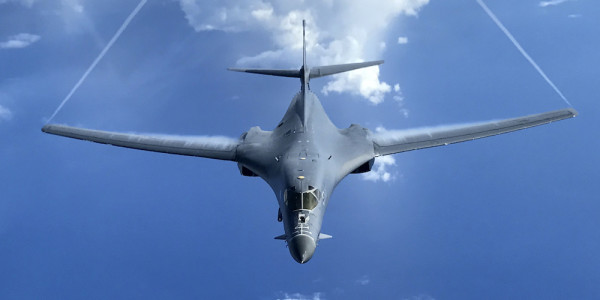

The B-1B Lancer, the backbone of the U.S. strategic bomber force and favorite aeronautical middle finger to North Korea, will dominate the skies through 2040 thanks to a few tweaks by the Air Force.
Aviation Week reported on Oct. 3 that the service branch is in the process of updating “the way it inspects, maintains and repairs” Rockwell International’s venerable supersonic heavy bomber. And thanks to a series of broad structural tests, the service currently “does not anticipate” the need for a formal life extension program to keep Air Force’s fleet of 62 “Bone” bombers scaring the crap out of America’s enemies for the next few decades.
Although the B-1B Lancer first entered service in 1986, the branch has been conducting fatigue testing on the bomber’s fuselage and wings in 2013 to ensure that the aircraft could continue to operate through its original projected lifespan of 2050. While the bombers’ F-101 engines were already subject to a life-extension regimen scheduled to wrap up by January 2019, Aviation Week reports that wing testing is currently 72% complete. And even though fuselage tests are just 20%, the fleet apparently looked intact enough for Brig. Gen. Michael Schmidt to tell Aviation Week the fleet wouldn’t require a “fully fledged” extension program.
This is good news for the Air Force, and not just because of the nuclear threat posed by North Korean dictator Kim Jong Un. Lancers deployed 3,800 munitions during a six-month period against ISIS in Iraq and Syria that ended in February 2016. A year later, in February 2017, Air Force Chief of Staff Gen. David Goldfein told reporters in Washington that the branch remained “pretty flexible” on returning the Lancer to the U.S. Central Command’s area of operations; the following July, Air Force Global Strike Command chief Gen. Robin Rand testified before the Senate Armed Services committee that the Bombers “will be in demand for at least two more decades.”
“[The B-1B Lancer] carries the largest payload of both guided and unguided weapons in the Air Force inventory,” Rand said. “This marks a fantastic capability upgrade, and the associated cockpit upgrades provide the crew with a much more flexible, integrated cockpit.”

A U.S. Air Force B-1B Lancer assigned to 37th Expeditionary Bomb Squadron, deployed from Ellsworth Air Force Base, South Dakota, takes off from Andersen Air Force Base, Guam, to fly a bilateral mission with two Koku Jieitai (Japan Air Self-Defense Force) F-15s, Sept. 9, 2017.Photo via DoD
Those updates put the B-1B Lancerin the middle range when it comes to AFGSC’s modernization efforts. The B-52 Stratofortress is in the middle of a full-blown modernization designed to keep the legendary long-range bomber flying for a full century; by contrast, the branch seems entirely unconcerned with the B-2 Spirit stealth bomber that went into service in 1997 — so much so that Schmidt told Aviation Week of the branch “ have full-scale fatigue testing going on in that platform.”
Of course, the B-1B Lancer will require some essential upgrades to its weapons and avionics system, on top of the current engine program, in order to forgo a full-blown life extension: With a $210 million projected cost through fiscal year 2022, the Integrated Battle Station (IBS)/Software Block-16 (SB-16) that Rand declared crucial to future operability marks the largest B-1 upgrade program in the aircraft’s history.
And while the Air Force’s budget request for fiscal year 2018 focuses specifically on updating all B-1B squadrons with fully integrated targeting pods, upgraded bomb racks, and increasingly encrypted radio and communications systems, the branch’s proposed $37.2 million budget decrease in the B-1B program is dependent on “deferring development of new sustaining engineering requirements for fuselage crown repair” for the aircraft — a bit alarming, given Schmidt’s optimistic outlook on an aircraft that’s only a fifth of the way through fuselage-fatigue testing.
Despite this, the bottom line is positive: The Air Force plans on keeping the cornerstone of its strategic bomber force intact, and on doing so as quickly and cheaply as possible. And given North Korea’s frustrating bellicosity, a fleet of shiny refurbished Lancers near the Korean peninsula may be just what the doctor ordered.
WATCH NEXT:
